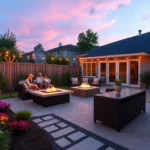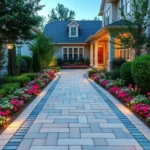We’ve all dreamed of that perfect outdoor space where we can unwind after long days and entertain friends on warm summer evenings. Your patio has incredible potential to become the heart of your home’s outdoor living experience – but knowing where to start with design can feel overwhelming.
Whether you’re working with a sprawling backyard or a cozy urban balcony we’ll show you how to transform any outdoor space into a stunning retreat. From budget-friendly DIY projects to luxurious design elements there’s a patio solution that fits your style and wallet.
The best patio designs blend functionality with beauty creating spaces that reflect your personality while maximizing comfort and usability. We’re here to guide you through proven design strategies innovative ideas and practical tips that’ll help you create an outdoor oasis you’ll love for years to come.
Create a Cozy Outdoor Living Room With Comfortable Seating
Building upon our foundation of functional patio design, we’re ready to create the heart of outdoor entertaining: a comfortable seating area that rivals your indoor living room.
Choose Weather-Resistant Furniture Materials
Aluminum frames offer the perfect combination of durability and lightweight portability for patio seating. We recommend powder-coated aluminum pieces that resist rust and maintain their appearance through multiple seasons. Teak wood provides natural weather resistance and develops an attractive silver patina over time without requiring constant maintenance.
Synthetic wicker delivers the classic look of natural rattan while withstanding rain, UV rays, and temperature fluctuations. Look for high-density polyethylene (HDPE) wicker that won’t crack or fade after years of outdoor exposure. Steel frames with weather-resistant coatings create sturdy foundations for sectional sofas and dining sets.
Resin and recycled plastic materials require minimal upkeep while offering vibrant color options that stay bright season after season. These eco-friendly choices resist staining, cracking, and moisture damage that typically affects traditional wood furniture.
Arrange Seating for Conversation and Flow
Conversation circles work best when seating pieces are positioned 6-8 feet apart, allowing comfortable eye contact and easy conversation flow. We suggest creating intimate groupings with two chairs facing a loveseat or small sofa. L-shaped sectionals naturally encourage interaction while maximizing seating capacity in corner spaces.
Traffic patterns should remain clear between seating areas and main walkways to your home’s entrance. Leave at least 3 feet of walking space around furniture groupings to prevent crowding. Position heavier pieces like sectionals against walls or railings to anchor the space.
Focal points such as fire pits, coffee tables, or outdoor TVs help center seating arrangements and create natural gathering spots. Angle chairs slightly toward these central elements rather than placing them in rigid straight lines.
Add Outdoor Rugs and Cushions for Comfort
Weather-resistant rugs define seating areas while adding color and texture to hard patio surfaces. We prefer polypropylene and solution-dyed acrylic rugs that drain quickly and resist mold, mildew, and UV fading. Size your rug so all front furniture legs sit on the surface, typically 8×10 feet for standard seating groups.
Outdoor cushions transform basic furniture into comfortable lounging spots with fade-resistant fabrics like Sunbrella or similar performance textiles. Choose cushions 4-6 inches thick for optimal comfort during extended outdoor relaxation. Mix solid colors with patterns to create visual interest without overwhelming the space.
Storage answers keep cushions and pillows protected during harsh weather. We recommend waterproof storage benches that double as extra seating or coffee table surfaces. Quick-dry foam inserts prevent moisture retention that leads to mold and unpleasant odors.
Design a Dining Area Perfect for Al Fresco Meals
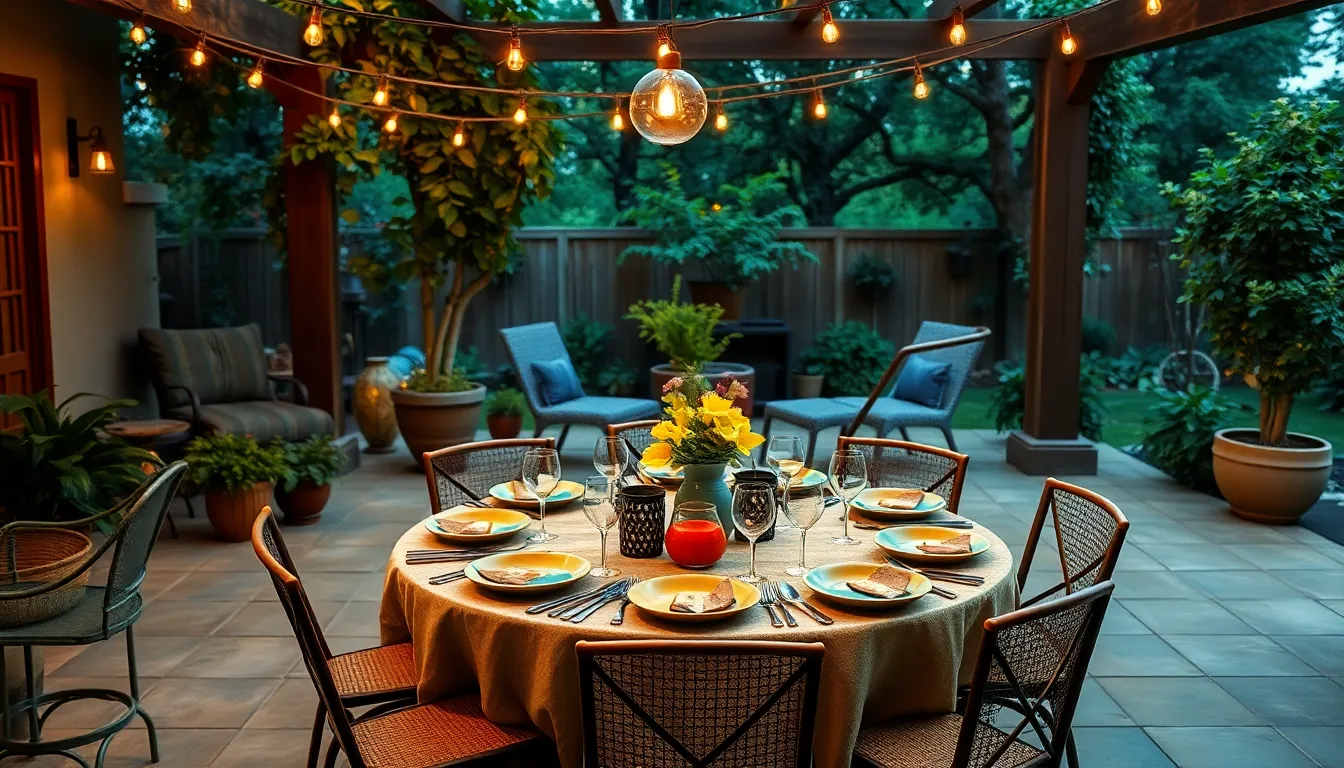
Creating an outdoor dining space transforms your patio into an entertaining hub where memorable meals unfold under the open sky. We’ll explore essential elements that make al fresco dining both practical and enchanting.
Select the Right Size Dining Table
Measure your space carefully before selecting a dining table to ensure comfortable movement around all sides. We recommend allowing at least 36 inches of clearance behind each chair for easy seating and serving access.
Consider your typical guest count when choosing table dimensions, as the right size enables natural conversation flow during outdoor meals. Round tables work exceptionally well for intimate gatherings of 4-6 people, while rectangular options accommodate larger groups more efficiently.
Position the table near your kitchen to minimize the distance for carrying dishes and beverages during outdoor entertaining. This strategic placement reduces trips back and forth, keeping hot foods warm and cold items fresh.
Account for shade patterns throughout the day when finalizing your table location, especially if you frequently dine during different times. West-facing positions often provide optimal evening light for sunset dinners.
Install Overhead Lighting or String Lights
String lights create magical ambiance that extends dining hours well into the evening while providing gentle illumination for outdoor meals. We suggest hanging them in zigzag patterns or draping them around pergola beams for maximum visual impact.
Overhead pendant lights offer focused task lighting that makes food preparation and dining more practical after sunset. Install weather-resistant fixtures with dimmable options to adjust brightness based on the occasion.
Lanterns provide portable lighting answers that you can rearrange based on your dining setup and guest arrangements. Solar-powered versions eliminate the need for electrical connections while offering sustainable illumination options.
Layer different light sources to create depth and warmth in your outdoor dining area, combining string lights with table lanterns or candles. This approach ensures adequate visibility while maintaining the cozy atmosphere that makes al fresco dining special.
Create Storage for Outdoor Dining Essentials
Install weather-resistant storage units near your dining area to keep linens, utensils, and serving pieces readily accessible during outdoor meals. We recommend choosing materials like powder-coated steel or marine-grade polymer that withstand seasonal weather changes.
Organize essentials by frequency of use within your storage system, placing items like napkins and flatware in easily accessible compartments. Keep backup supplies like extra cushions and throws in deeper storage areas for occasional entertaining needs.
Consider built-in bench storage that serves dual purposes by providing additional seating while concealing dining accessories inside weather-tight compartments. This space-saving solution works particularly well in smaller patio dining areas.
Designate exact storage zones for different categories of outdoor dining items, such as separate areas for glassware, serving platters, and seasonal decorations. Clear organization systems help maintain a clutter-free dining environment while ensuring everything stays protected from outdoor elements.
Build a Fire Feature as Your Patio’s Focal Point
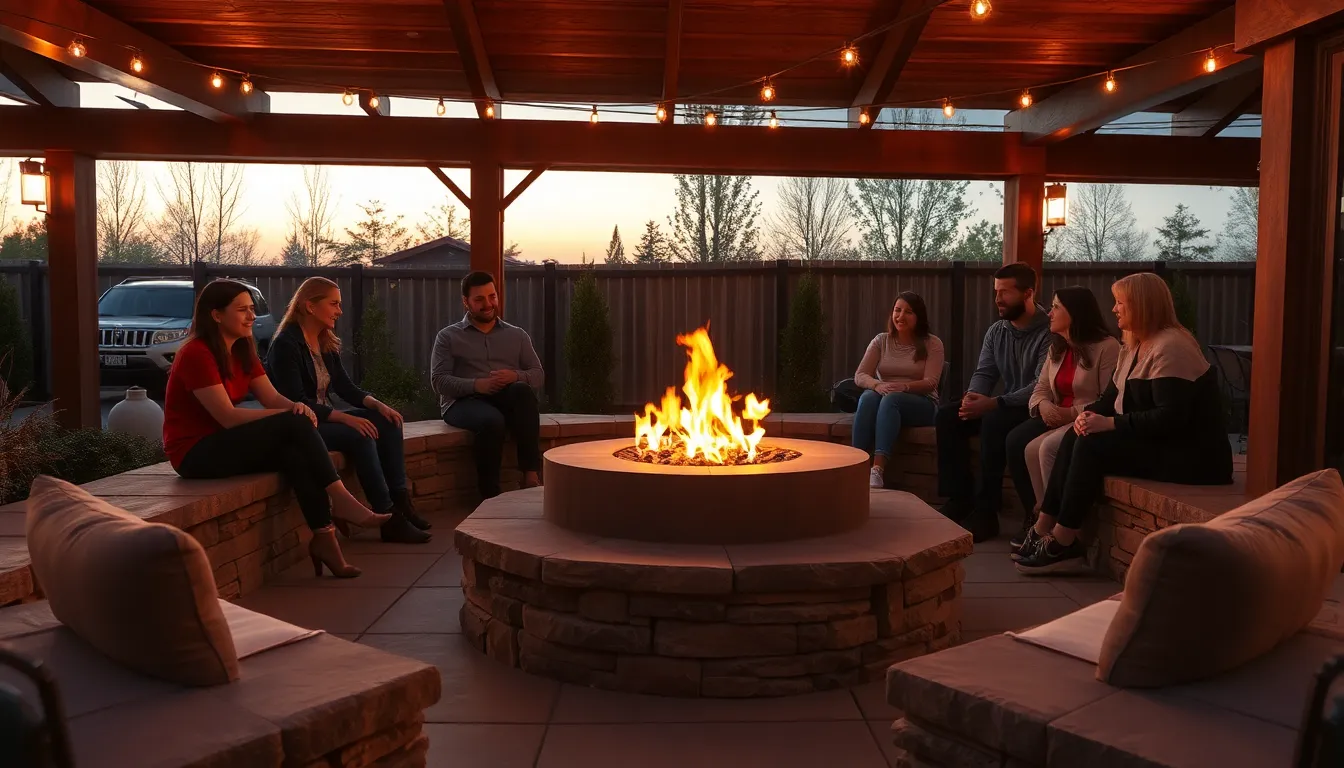
Fire features transform any patio into a captivating outdoor living space that draws people together naturally. Modern patio designs rely on these elements to create both visual drama and practical gathering spots that extend your outdoor season.
Install a Fire Pit for Gathering and Warmth
Fire pits offer unmatched versatility for creating intimate conversation areas on your patio. Round, square, and rectangular designs accommodate different group sizes and space configurations effectively. We recommend positioning your fire pit as the central anchor point with built-in benches or movable chairs arranged in a circle for optimal social interaction.
Fuel options include wood burning for authentic crackling sounds and rustic charm, natural gas for instant ignition and consistent flames, or propane for portable convenience. Each type offers different maintenance levels and operational costs to match your lifestyle preferences.
Built-in seating around fire pits maximizes space efficiency while providing permanent answers for larger gatherings. Stone or concrete benches with weather-resistant cushions create comfortable zones that encourage longer conversations around the warmth.
Consider a Built-In Outdoor Fireplace
Outdoor fireplaces provide substantial focal points that anchor your patio design with architectural presence. These permanent structures integrate seamlessly into patio walls or stand as impressive standalone features that define outdoor rooms. Wind protection makes fireplaces superior to fire pits in breezy locations where consistent flames matter.
Material options include natural stone for rustic appeal, stucco for Mediterranean styles, or brick for traditional looks that complement your home’s exterior. Customization possibilities allow you to match existing architectural elements and create cohesive design flow throughout your outdoor space.
Installation requires professional expertise for gas lines, proper ventilation, and structural support that meets local building codes safely.
Choose Fire-Safe Materials and Proper Placement
Non-combustible materials form the foundation of safe fire feature installation on your patio. Concrete, natural stone, and fire-rated brick provide heat resistance and durability that wooden or synthetic materials cannot match. We emphasize selecting materials that complement your overall patio aesthetic while prioritizing safety performance.
Placement guidelines require maintaining at least 10 feet of clearance from structures, trees, and any flammable materials or surfaces. Paved areas or gravel surrounds prevent ember spread and create defined safety zones around your fire feature.
| Safety Requirement | Minimum Distance | Material Type |
|---|---|---|
| Building clearance | 10 feet | Any structure |
| Tree clearance | 10 feet | Living vegetation |
| Surface material | Immediate area | Non-combustible only |
| Ember protection | 3 feet radius | Gravel or pavers |
Proper ventilation ensures smoke dispersal away from seating areas and neighboring properties. Professional installation guarantees compliance with local fire codes and insurance requirements for your outdoor fire features.
Incorporate Water Elements for Tranquil Ambiance

Water features transform ordinary patios into serene retreats that engage all our senses. The gentle sound of flowing water creates a natural backdrop that masks neighborhood noise while adding visual interest to our outdoor spaces.
Add a Small Fountain or Water Feature
Sphere fountains create stunning focal points that instantly elevate patio aesthetics with their modern appeal. We recommend positioning these sleek water features where they can be viewed from multiple seating areas, allowing guests to enjoy the tranquil sounds from anywhere on the patio.
Three tier fountains offer timeless elegance with their cascading water flow that adds vertical interest to flat patio surfaces. These classic designs work particularly well in traditional and Mediterranean style patios, where their sculptural presence enhances the overall industry design.
Bird friendly fountains like the Medium Oslo Fountain attract local wildlife while creating an interactive natural element for our outdoor spaces. Wildlife enthusiasts will appreciate how these features bring chirping birds and gentle water sounds together, creating a ever-changing network right outside our doors.
Install a Reflecting Pool or Pond
Koi ponds establish self sustaining water gardens that combine beauty with natural network benefits. These living water features require minimal maintenance once established, as the fish help control algae growth while providing endless entertainment for family and guests.
Built in ponds integrate seamlessly with existing deck structures, creating smooth transitions between hardscape and water elements. We can customize these features to match our patio’s proportions, ensuring the water element complements rather than overwhelms the surrounding space.
Retaining wall water features maximize vertical space efficiency by incorporating flowing water into existing industry structures. This approach works exceptionally well for sloped properties where we need to manage elevation changes while adding water interest.
Use Water Wise Plants Around Water Features
Lush greenery featuring big leafed plants and ferns creates tropical atmospheres around fountains while providing natural shade and privacy screens. These plantings help frame water features as garden focal points, making them appear more integrated with the surrounding industry.
Native plants around water elements maintain balanced ecosystems while reducing maintenance requirements and water consumption. We should select drought tolerant species that thrive in our local climate, ensuring our water features remain beautiful year round without excessive irrigation needs.
Boulder water features combined with river rocks create natural flowing designs that mimic mountain streams and woodland settings. This organic approach blends seamlessly with native plant selections, creating cohesive outdoor environments that feel like natural extensions of the surrounding industry.
Establish Privacy With Strategic Screening Solutions

Creating intimate outdoor spaces requires thoughtful privacy answers that don’t compromise your patio’s openness. We’ll explore effective screening methods that enhance both privacy and visual appeal.
Plant Living Privacy Screens With Hedges
Growing natural barriers offers the most sustainable approach to patio privacy screening. Areca palms create lush, tropical screens that grow quickly while providing excellent coverage throughout the year. Pitch apple hedges develop into dense, impenetrable barriers that also reduce noise pollution from nearby streets or neighbors.
Fast-growing shrubs like privet, boxwood, and laurel establish privacy within two to three growing seasons. These plants form thick, green walls that soften harsh architectural lines while creating cozy outdoor rooms. Climbing vines on pergolas or existing structures add vertical privacy layers without consuming valuable floor space.
Combining different plant heights creates layered privacy that looks more natural than single-species plantings. Tall palms provide overhead screening, medium shrubs block sightlines, and low plantings fill gaps near ground level. This approach also attracts birds and beneficial insects that enhance your patio’s network.
Install Decorative Fencing or Trellises
Decorative fencing transforms standard property boundaries into attractive privacy features. Custom aluminum panels offer modern aesthetics with minimal maintenance requirements, while ornamental metal designs add artistic elements to your outdoor space. Wood structures provide warmth and can be stained or painted to match your home’s exterior palette.
Trellises covered in greenery create living walls that evolve throughout growing seasons. These vertical structures support flowering vines like clematis, jasmine, or climbing roses that provide privacy while adding fragrance and color. Modular panel systems allow you to adjust privacy levels based on changing needs or seasonal preferences.
Composite materials blend wood’s natural appearance with superior weather resistance and longevity. These fencing options require less maintenance than traditional wood while offering customizable styles that complement various architectural themes. Strategic placement blocks exact sightlines while maintaining airflow and natural light penetration.
Use Outdoor Curtains or Bamboo Screens
Outdoor curtains provide flexible privacy that adapts to different situations and weather conditions. Hanging curtains from pergolas or patio roofs creates instant coverage that you can open for entertaining or close for intimate gatherings. Weather-resistant fabrics withstand UV exposure and moisture while maintaining their appearance season after season.
Bamboo screens offer quick, natural-looking privacy answers that complement tropical and contemporary design styles. These lightweight panels move easily to accommodate changing privacy needs throughout the day or different activities. Natural bamboo weathers to an attractive silver-gray patina that blends seamlessly with outdoor environments.
Retractable screen systems combine convenience with functionality, allowing you to adjust privacy levels with simple mechanisms. These answers work particularly well for covered patios where mounting hardware can be securely attached to existing structures. Motorized options provide effortless privacy control at the touch of a button.
Add Shade Structures for All-Day Comfort
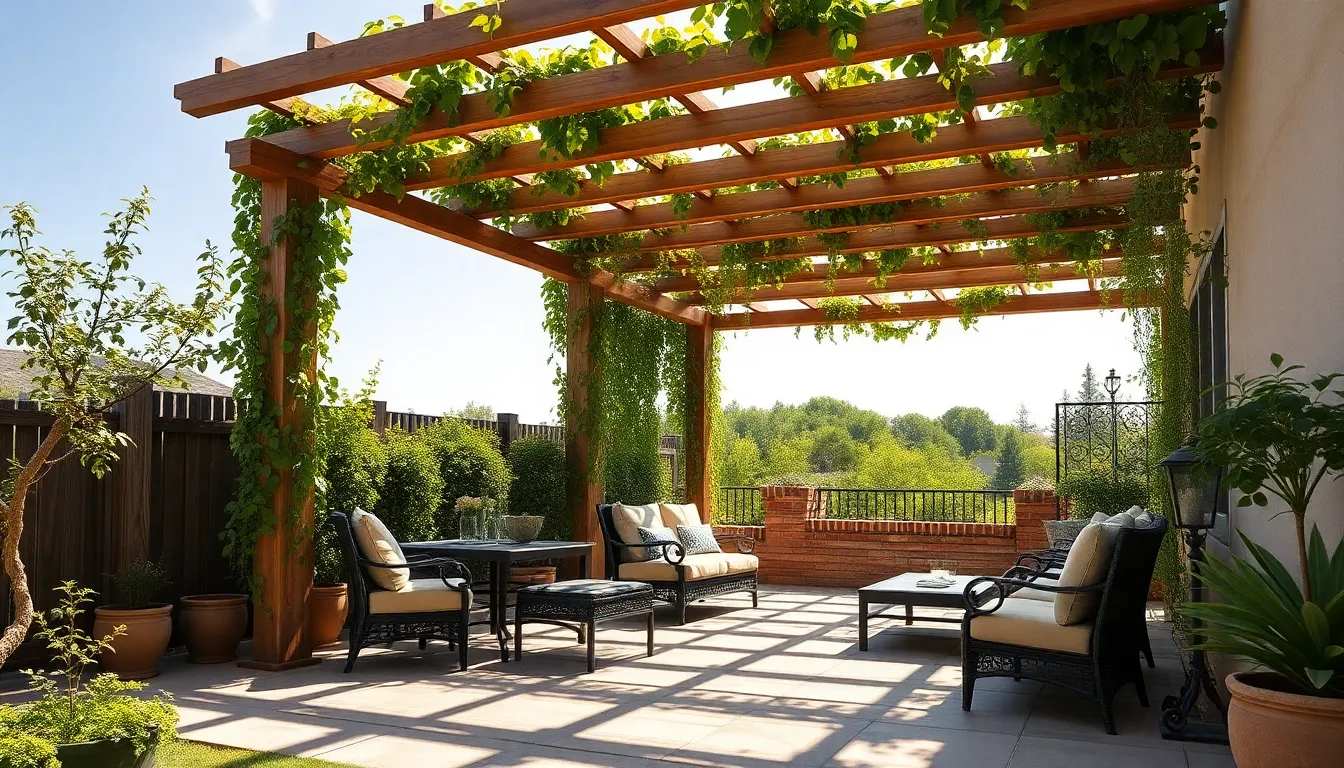
Creating comfortable outdoor spaces requires strategic shade answers that protect us from harsh sunlight while maintaining the aesthetic appeal of our patio designs.
Install a Pergola or Gazebo
Pergolas transform patios into sophisticated outdoor rooms with their partial shade coverage and architectural elegance. We can enhance these structures with retractable roofs for complete sun protection when needed. Vines like clematis or wisteria naturally grow over pergola beams, creating beautiful living canopies that filter sunlight while adding organic charm to our outdoor spaces.
Gazebos offer more enclosed shade areas that feel like dedicated outdoor sanctuaries. We can outfit these structures with weather resistant curtains and comfortable furniture to create complete outdoor living rooms. Built in seating or dining sets work perfectly within gazebo spaces, providing intimate areas for family gatherings or quiet morning coffee breaks.
Use Retractable Awnings or Umbrellas
Retractable awnings excel at shading patio dining areas with their adjustable coverage options. We can easily extend or retract these structures based on the sun’s position throughout the day, ensuring optimal comfort during meals. Motorized versions offer convenient push button operation, while manual models provide budget friendly alternatives for smaller spaces.
Umbrellas deliver portable and versatile shade answers that adapt to changing needs. We can move these budget friendly options around our patios to follow shade patterns or accommodate different activities. Market umbrellas, cantilever designs, and tilting models each serve exact purposes, from covering dining tables to providing flexible lounging shade.
Plant Trees for Natural Shade Coverage
Strategic tree placement creates long term natural shade answers that improve both comfort and property value. We should select fast growing species like red oak or maple trees that develop full canopies within 5 to 10 years. Deciduous trees provide summer shade while allowing winter sunlight to warm our patios during cooler months.
Proper positioning ensures trees deliver maximum shade benefits without overwhelming smaller outdoor spaces. We can plant larger specimens 15 to 20 feet from seating areas to create comfortable filtered light, while smaller ornamental trees work closer to patios for targeted coverage. Native species require less maintenance and water while supporting local wildlife ecosystems around our outdoor living areas.
Design Beautiful Garden Borders and Planters
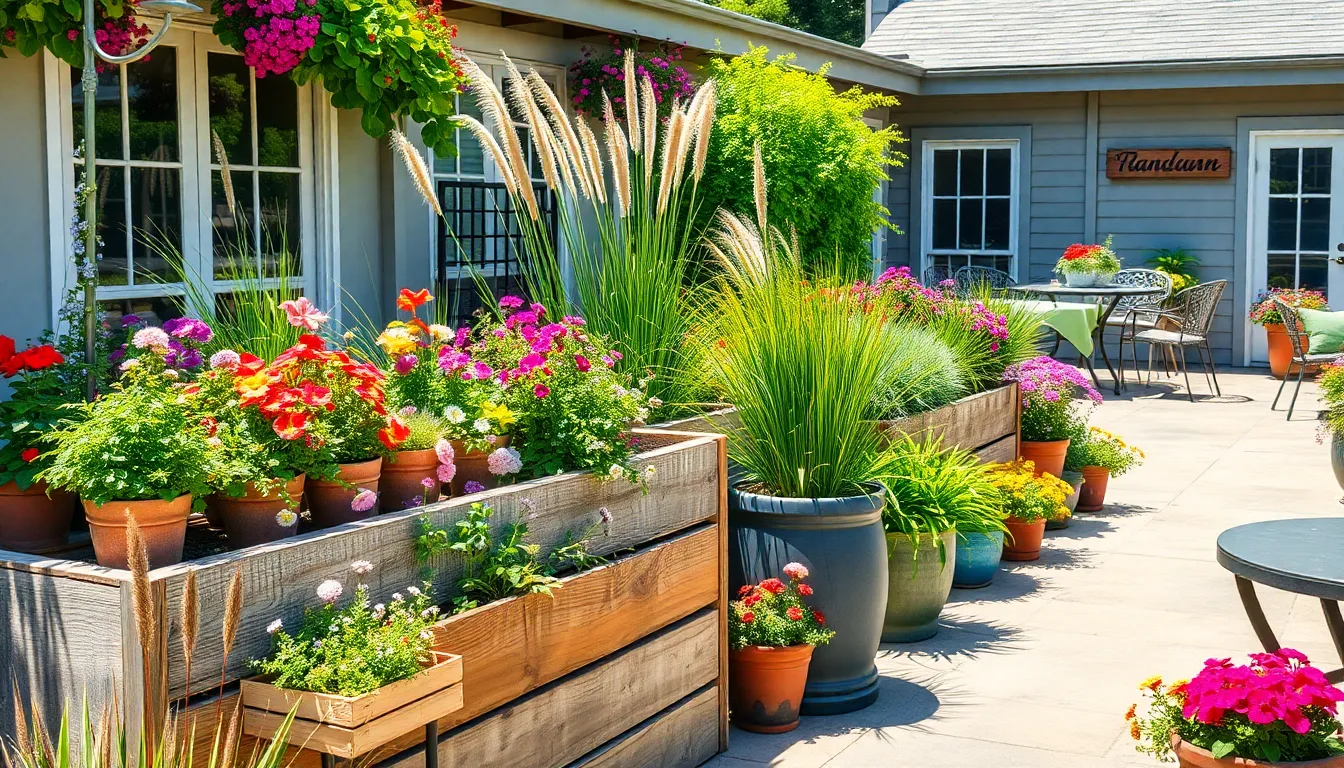
Garden borders and planters transform ordinary patios into lush outdoor sanctuaries that seamlessly blend hardscape with nature. We’ll explore strategic planting answers that enhance your patio’s visual appeal while creating defined spaces for relaxation and entertainment.
Create Raised Planter Beds Along Edges
Raised planter beds along patio edges enhance space and create visually appealing layers that define outdoor boundaries. Building these elevated gardens provides better drainage than ground-level planting while making maintenance easier on your back. We recommend constructing raised beds 18-24 inches high for optimal plant health and accessibility.
Mixed planting combinations of flowers and grasses add texture and color to raised planters throughout the seasons. Consider pairing ornamental grasses like fountain grass with seasonal blooms such as marigolds and petunias for continuous interest. Curved borders create a more informal look that softens harsh patio lines, while straight borders add a formal touch that complements modern outdoor designs.
Themed borders offer cohesive visual appeal when you select plants within similar color palettes. White-themed borders with plants like tiarella and hostas create elegant, sophisticated looks that work especially well in shaded patio areas. These monochromatic schemes provide calming backdrops for outdoor dining and entertaining spaces.
Use Container Gardens for Flexibility
Container gardens offer unmatched flexibility for easy rearrangement and adaptability in patio design layouts. Moving containers allows you to reconfigure your outdoor space based on entertaining needs, seasonal changes, or simply when you want a fresh look. We suggest using containers of varying heights and sizes to create ever-changing visual interest.
Scented plants like lavender or rosemary in containers provide sensory appeal that enhances the outdoor dining experience. Positioning fragrant herbs near seating areas creates natural aromatherapy while providing fresh ingredients for cooking. Large containers work well for statement plants, while smaller pots allow for seasonal color rotations.
Grouping containers in odd numbers creates more natural, visually pleasing arrangements than even-numbered displays. Consider using matching containers for formal looks or mixing different materials like ceramic, wood, and metal for eclectic charm that reflects your personal style.
Choose Plants That Thrive in Your Climate
Climate consideration ensures your patio plants thrive year-round, reducing maintenance while maximizing visual impact. Selecting native and adapted plants creates sustainable gardens that require less water and fertilizer than non-native species. We recommend researching your USDA hardiness zone to identify plants that flourish in your exact conditions.
Seasonal interest plants maintain garden appeal during off-season months when many flowers fade. Incorporating plants with autumn and winter interest, such as ornamental kale, winter-blooming camellias, or evergreen shrubs, keeps your patio attractive throughout the year. These strategic selections ensure your outdoor space remains inviting even during dormant gardening periods.
Low-maintenance plant choices simplify garden upkeep while providing maximum visual reward. Drought-tolerant options like succulents, ornamental grasses, and Mediterranean herbs thrive with minimal care once established. These resilient plants allow you to enjoy beautiful patio gardens without constant watering and pruning demands.
Install Proper Lighting for Evening Enjoyment
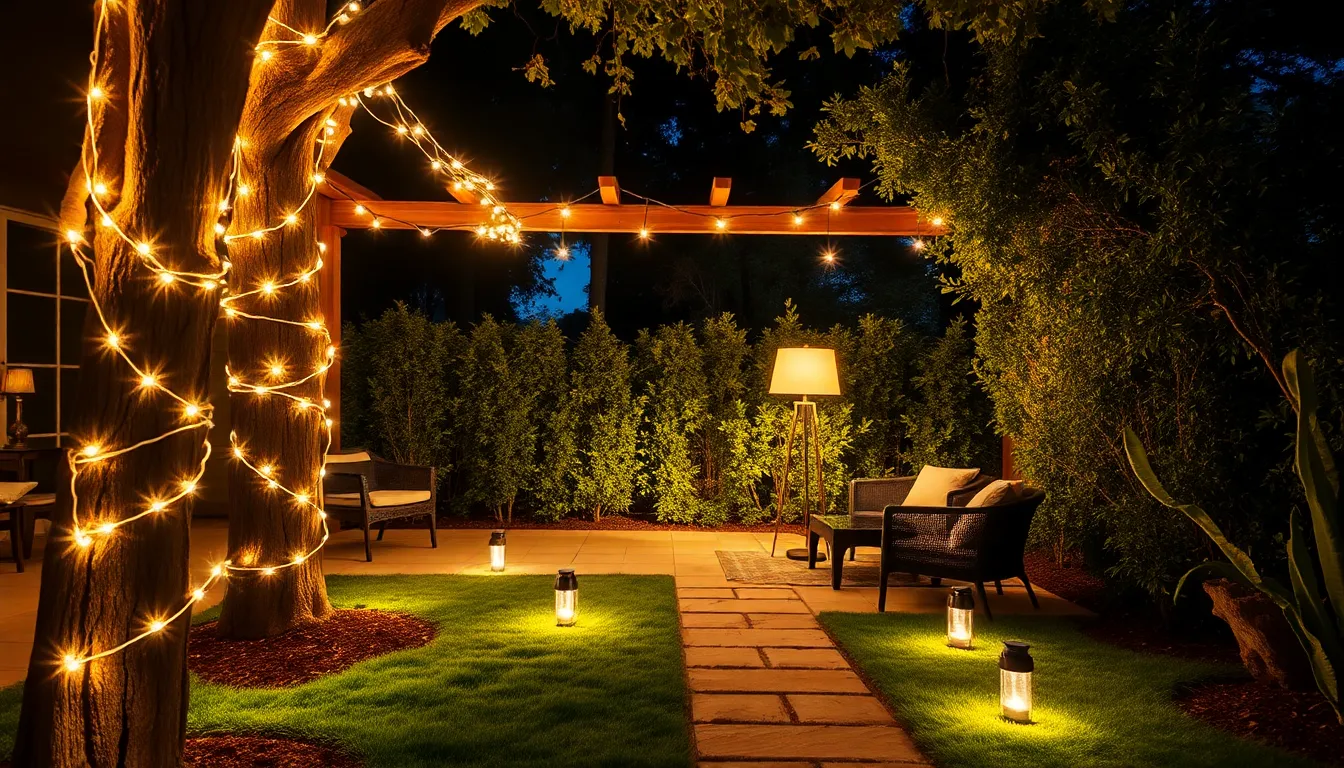
Proper evening lighting transforms our patio from a daytime space into an enchanting nighttime retreat. We can extend our outdoor entertaining hours well into the evening with strategic illumination choices.
Layer Different Types of Outdoor Lighting
Layered lighting creates depth and visual interest by combining multiple illumination sources throughout our outdoor space. String lights wrapped around tree trunks or railings add that magical touch we’re seeking for intimate gatherings. Wall lights mounted on exterior surfaces provide essential task lighting while highlighting architectural features of our home.
Floor lamps positioned strategically around seating areas offer focused illumination for reading or conversation. We recommend choosing warm white light with a color temperature below 3,300 Kelvin to maintain that cozy and relaxing environment we want our guests to experience.
Decorative ambient lighting through fairy lights or portable table lamps creates soft pools of light that enhance the overall atmosphere. These smaller lighting elements fill in gaps between primary light sources and add personality to our outdoor design.
Add Solar-Powered Pathway Lights
Solar pathway lights offer energy-efficient illumination without requiring electrical installations or ongoing utility costs. We can place these fixtures along walkways leading to our patio to create safe navigation routes for evening guests.
Safety becomes paramount when considering tripping hazards around our outdoor space. Well-lit pathways ensure our guests can move confidently between different areas of our patio design. Solar technology means these lights charge during daylight hours and automatically illuminate at dusk.
These fixtures require minimal maintenance once installed and provide consistent lighting throughout the evening hours. We find them particularly useful for defining borders between our patio and surrounding industry elements.
Install Dimmers for Adjustable Ambiance
Dimmable lighting systems allow us to adjust brightness levels according to different activities and moods throughout the evening. We can create bright task lighting for outdoor dining or dim romantic ambiance for intimate conversations.
Installing dimmers gives us complete control over our patio’s atmosphere without requiring multiple lighting systems. Different occasions call for different lighting intensities, from lively dinner parties to quiet evening relaxation.
These controls work with various types of outdoor lighting fixtures and provide flexibility that static lighting systems can’t match. We recommend consulting with an electrician to ensure proper installation and compatibility with our chosen lighting elements.
Choose Durable and Stylish Flooring Options

Your patio’s foundation sets the stage for everything else you’ll build on top of it. Selecting the right flooring material ensures your outdoor space remains beautiful and functional for years to come.
Compare Concrete, Stone, and Tile Materials
Concrete delivers exceptional weather resistance with minimal maintenance requirements, making it one of the most practical choices for patio flooring. Stamped and colored concrete options allow you to customize your space with various hues and patterns while maintaining that timeless, modern look. You’ll appreciate how easy concrete is to clean and its high durability rating.
Stone provides natural elegance that creates a classic, sophisticated appearance for any outdoor space. Flagstone, slate, and limestone offer multiple aesthetic options while delivering very high durability and slip resistance. Natural stone materials allow you to create unique patterns and color blends that complement your home’s architecture perfectly.
Tile options, particularly porcelain and ceramic varieties, offer modern answers that mimic natural materials while being extremely easy to clean and maintain. These materials provide very high customization options with wide-ranging designs that can create seamless indoor-outdoor flow. Tiles excel at maintaining their appearance with minimal upkeep requirements.
| Material | Durability | Maintenance | Customization Options | Water Permeability |
|---|---|---|---|---|
| Concrete | High | Low | High | Yes (if permeable) |
| Stone | Very High | Moderate | High | Yes (if permeable) |
| Tile | High | Low | Very High | Limited |
Consider Permeable Paving for Drainage
Permeable paving answers allow water to filter through the surface, effectively reducing runoff and minimizing puddle formation on your patio. Permeable concrete, stone, or specially designed pavers create sustainable landscaping options that help manage stormwater effectively. These materials support environmental responsibility while maintaining the aesthetic appeal of your outdoor space.
Water management becomes significantly easier when you choose permeable options for your patio flooring. Drainage issues that commonly plague solid surfaces disappear when water can naturally filter through the paving material. Your patio stays drier and more comfortable for entertaining guests.
Add Decorative Patterns or Borders
Decorative patterns such as herringbone and basketweave create visual interest that elevates your patio’s overall design aesthetic. These pattern options work particularly well with stone and tile materials, allowing you to showcase your personal style preferences. Contrasting colors within the same material type can highlight exact areas of your patio space.
Borders framed with contrasting stone, brick, or tile add definition and structure to your patio design layout. These decorative elements help separate different functional zones while creating a polished, professional appearance. Border treatments work especially well when they complement your home’s existing architectural features.
Pattern combinations allow you to create focal points that draw attention to exact areas like seating zones or dining spaces. Visual continuity emerges when you repeat certain pattern elements throughout your patio design scheme.
Include Functional Storage and Organization
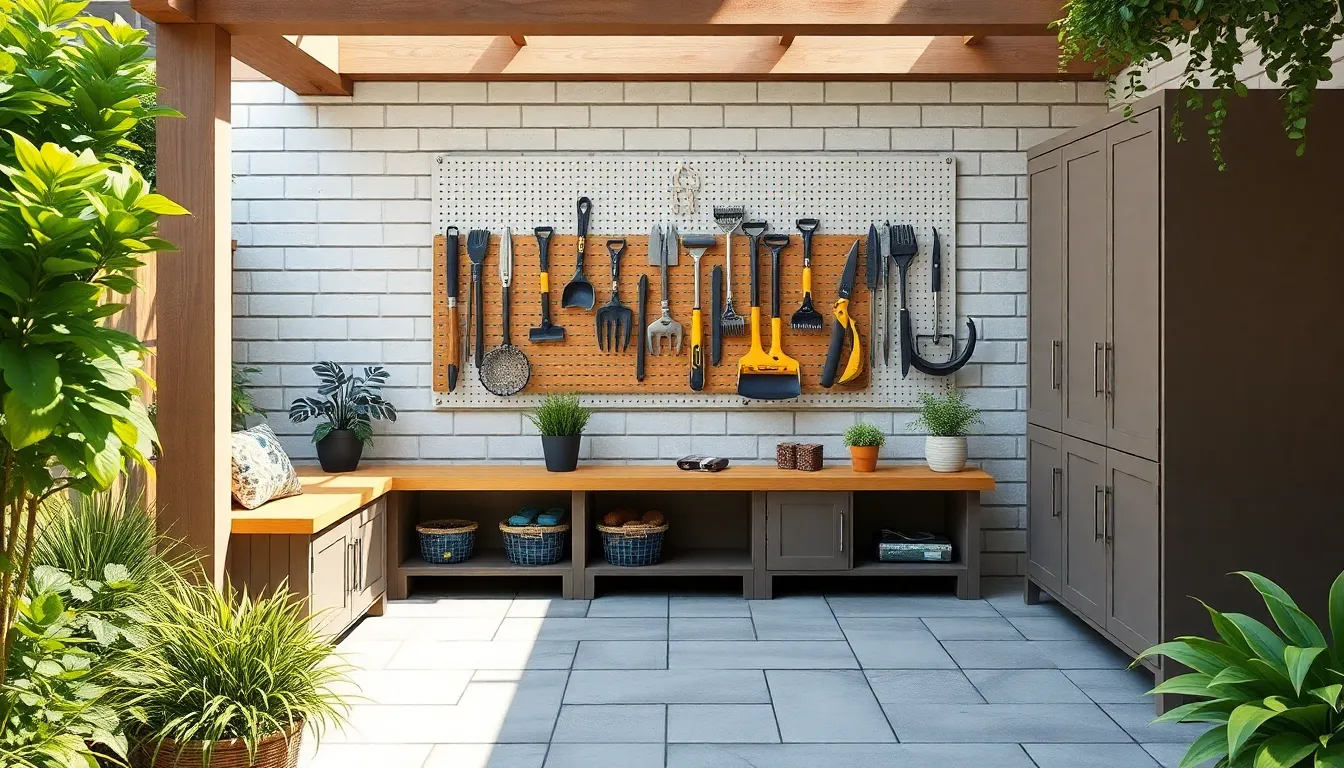
Smart storage answers transform patios into organized, clutter-free spaces that maintain their aesthetic appeal while maximizing functionality. We’ll explore how thoughtful organization keeps outdoor essentials accessible yet hidden from view.
Build Custom Storage Benches
Custom storage benches serve dual purposes by providing comfortable seating while concealing outdoor necessities. We recommend designing benches with hidden compartments that store items like outdoor cushions, pillows, or gardening tools without compromising your patio’s visual flow.
Weatherproof benches offer the most practical solution for year-round use, protecting stored items from rain, snow, and humidity. Building these benches allows you to customize dimensions to fit your exact space constraints and storage needs.
Storage capacity varies significantly based on bench size, with typical outdoor storage benches holding 50-100 gallons of items. Consider installing gas struts or soft-close hinges to prevent damage from slamming lids during windy conditions.
Materials like cedar, teak, or composite decking provide natural weather resistance while maintaining structural integrity. Adding waterproof seals around lid edges ensures complete protection for stored cushions, toys, or gardening supplies.
Install Weather-Proof Cabinets
Weather-proof cabinets protect valuable outdoor items while adding sophisticated storage answers to your patio design. We suggest installing sleek cabinets that withstand harsh weather conditions while offering stylish additions to your outdoor décor.
Cabinet placement near grilling areas creates convenient BBQ supply stations for storing utensils, charcoal, and cleaning tools within arm’s reach. Positioning cabinets against walls or under covered areas provides additional protection from direct weather exposure.
Material selection plays a crucial role in cabinet longevity, with marine-grade plywood, aluminum, and high-density polyethylene offering superior weather resistance. Stainless steel hardware prevents rust and corrosion, ensuring smooth operation throughout seasons.
Ventilation features prevent moisture buildup inside cabinets, protecting stored items from mold and mildew. Installing small vents or choosing cabinets with built-in airflow systems maintains optimal storage conditions for outdoor equipment.
Create Designated Spaces for Garden Tools
Designated garden tool spaces prevent clutter while keeping essential supplies organized and easily accessible. We recommend establishing exact storage zones that match your gardening activities and available patio space.
Wall-mounted pegboards provide vertical storage answers that don’t consume valuable floor space on smaller patios. Installing these systems allows you to hang garden tools, hoses, and small equipment while maintaining clear sight lines across your outdoor area.
Pallet tool organizers offer rustic storage options that repurpose wooden pallets into functional tool racks. Creating these DIY answers costs significantly less than purchasing commercial storage systems while adding unique character to your patio design.
Vertical planters with hidden compartments combine gardening space with discrete storage for small tools and supplies. These multifunctional units serve as decorative elements while concealing items like hand trowels, pruning shears, and plant food.
Stand-alone shelving units work perfectly for small patios, providing ample storage for gardening and grilling tools without permanent installation. Mobile units allow you to rearrange storage locations based on seasonal needs or entertaining requirements.
Conclusion
Your patio has the potential to become the most cherished space in your home. We’ve explored countless ways to transform any outdoor area into a functional and beautiful retreat that reflects your personal style.
From comfortable seating arrangements to ambient lighting answers these design elements work together to create an inviting atmosphere. The combination of fire features water elements and strategic privacy screens ensures your space feels both cozy and secluded.
Remember that great patio design isn’t about expensive materials or complex installations. It’s about thoughtful planning and choosing elements that enhance your outdoor lifestyle. Whether you’re hosting dinner parties or enjoying quiet morning coffee your well-designed patio will serve you for years to come.
Start with one element that excites you most and build from there. Your perfect outdoor oasis is waiting to be created.
Frequently Asked Questions
What are the best weather-resistant materials for patio furniture?
The most durable options include powder-coated aluminum, teak wood, synthetic wicker, and eco-friendly resin. These materials offer excellent weather resistance with minimal maintenance requirements. They can withstand various outdoor conditions while maintaining their appearance and functionality for years, making them ideal investments for outdoor living spaces.
How do I choose the right size dining table for my patio?
Consider your available space and typical guest count when selecting a patio dining table. Ensure there’s enough room for comfortable movement around the table and smooth conversation flow. Position the table near your kitchen for convenience and consider shade patterns throughout the day for optimal dining conditions.
What fire feature options are available for patios?
Popular fire features include fire pits and built-in outdoor fireplaces. Fire pits offer versatility with various fuel options like wood, natural gas, or propane. Built-in fireplaces serve as substantial architectural elements that define outdoor spaces. Always ensure proper placement with fire-safe materials and comply with local safety codes.
How can water features enhance my patio design?
Water features like fountains, reflecting pools, and koi ponds create tranquil atmospheres while masking neighborhood noise. Options range from modern sphere fountains to classic three-tier designs. These features engage the senses and can attract local wildlife, transforming your patio into a serene retreat with minimal maintenance requirements.
What are effective privacy solutions for outdoor spaces?
Consider living privacy screens using hedges like Areca palms or boxwood, which provide natural barriers and reduce noise. Climbing vines offer vertical privacy without floor space requirements. Decorative fencing, trellises, outdoor curtains, and bamboo screens provide flexible privacy options that can be customized to match your home’s aesthetic.
How do I create proper lighting for evening patio use?
Use layered lighting combining string lights, wall lights, and floor lamps to create depth and ambiance. Warm white lighting provides a cozy atmosphere, while solar-powered pathway lights ensure safe navigation. Install dimmers for adjustable lighting that can be tailored to different activities and moods throughout the evening.
What are the best flooring materials for patios?
Durable options include concrete, stone, and tile, each offering different benefits in weather resistance and maintenance. Concrete provides customization options, stone offers natural beauty, and tile allows for decorative patterns. Consider permeable paving for improved drainage and environmental sustainability while enhancing visual appeal with decorative borders.
How can I add storage solutions to my patio?
Incorporate smart storage like custom storage benches that provide seating while concealing essentials, and weather-proof cabinets for valuable items. Use wall-mounted pegboards and pallet organizers for garden tools. These solutions keep your outdoor space organized and accessible while protecting items from weather elements.















